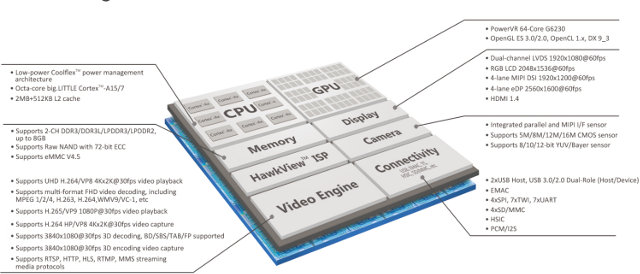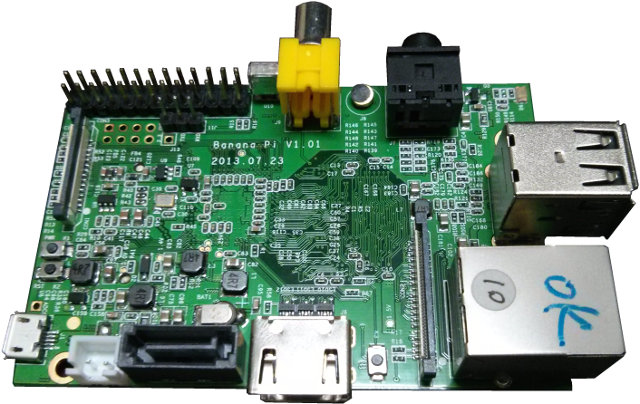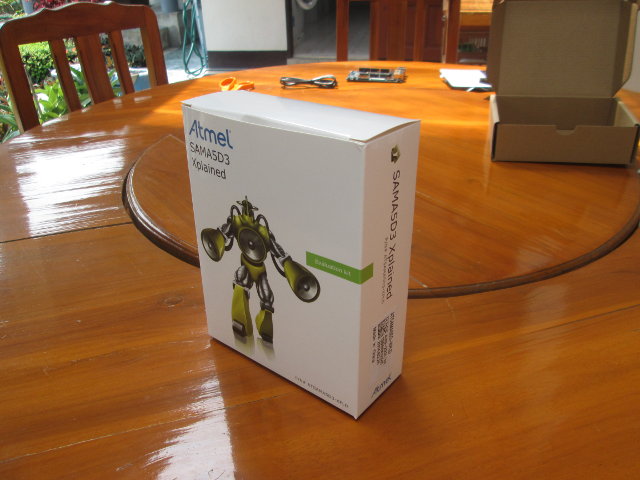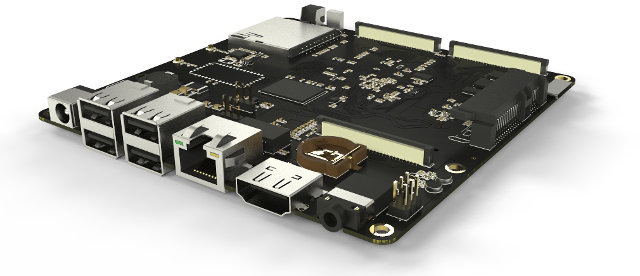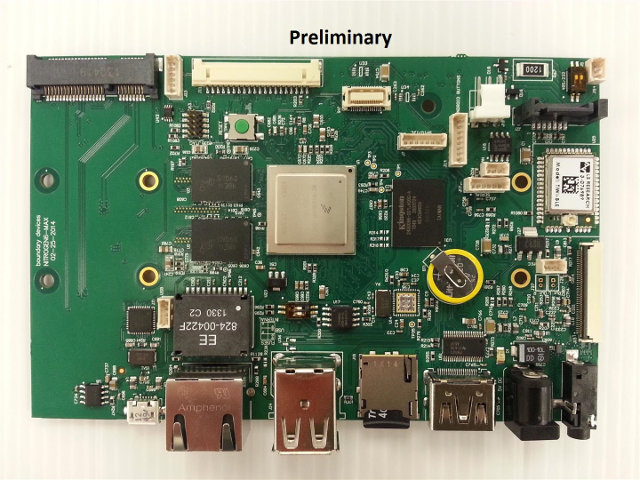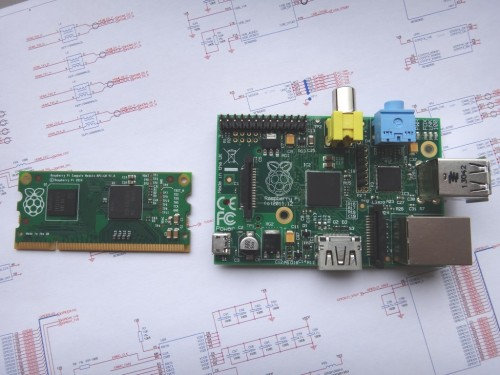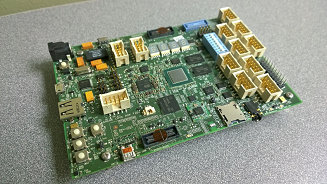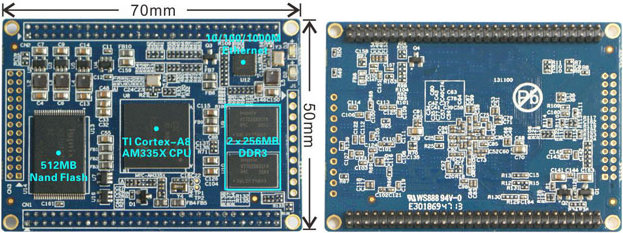AllWinner has released some more materials about their AllWinner A80 Ultracore octa core big.LITTLE SoC ahead of the Hong Kong Electronics Fair 2014, and we’ve learned more about OptimusBoard, as well as tablets and TV boxes availability through a video interview shot by Charbax at the exhibition. Part of the release was more detailed specifications: CPU Octa-Core big.LITTLE Cortex-A15/7 Low-power CoolFlex power management architecture 2MB + 512 KB L2 Cache GPU – Imagination Technologies PowerVR 64-core G6230 with support for OpenGL ES 3.0/2.0, OpenCL 1.x, RenderScript, DX 9.3/10.0 Memory Supports dual-channel DDR3/DDR3L/LPDDR3/LPDDR2, up to 8GB Supports Raw NAND with 72-bit ECC Supports eMMC V4.5 Video Supports UHD H.264/VP8 4Kx2K@30fps video playback Supports multi-format FHD video decoding, including MPEG 1/2/4, H.263, H.264. WMV9/VC-1, etc Supports H.265/VP9 1080p@30fps video playback Supports H.264 HP/VP8 4Kx2K@30fps video capture Supports 3840×1080@30fps 3D decoding, BD/SBS/TAB/FP supported Supports 3840×1080@30fps 3D encoding Supports RTSP, HTTP, HLS, RTMP, MMS […]
Banana Pi is a Raspberry Pi Compatible Board fitted with an AllWinner A20 SoC
So you’ve got a Raspberry Pi board, an enclosure, and a few add-on boards. Your application would however do with some more processing power, or you’d like to run Android, but you don’t want to have to purchase accessories all over again for another board. Banana Pi could be the solution, as it’s apparently [Update: it’s not. See comments] mechanically and electrically compatible with the Raspberry Pi, and comes with a dual core Cortex A7 AllWinner A20 SoC with 1GB RAM, a Gigabit Ethernet port, and a SATA port, among other things. The board does indeed look familiar, with all external connectors at the exact same positions, but the hardware specs are fairly different: SoC- Allwinner A20 dual core Cortex A7 processor @ 1 GHz with Mali-400MP2 GPU System Memory – 1 GB RAM Storage – SD card slot, SATA connector Video output – HDMI, Composite, and LVDS/RGB Audio I/O […]
Atmel SAMA5D3 Xplained Board Unboxing and Quick Start Guide
Atmel SAMA5D3 Xplained is an evaluation board running Linux powered by SAMA5D36 ARM Cortex A5 micro-processor with 256 MB DDR2, 256 MB flash, two Ethernet ports, 3 USB connectors, and more. This embedded board targets industrial automation, networks, robotics, control panels and wearable applications. The only video output is an LCD connector so it is reserved for headless or flat panel based applications. You can check full specs on my Atmel SAMA5D3 Xplained announcement post. The company kindly sent me a sample, so that I can share my experience with the board. I’ll first post some unboxing pictures, show how to get started with the pre-installed image, and build my own Linux image. The board can be purchased for $79 from Atmel e-Store, as well as several distributors (P/N: ATSAMA5D3-XPLD). Atmel SAMA5D3 Xplained Unboxing I’ve been sent the board via DHL in the following package, which gives a short desscription […]
Mixtile LOFT-Q Board and LOFT Kit mini PC Powered by AllWinner A31
Recently most development around AllWinner, at least for Linux, is focusing on AllWinner A20, and there are several AllWinner A20 board and development platforms available on the market such as Cubieboard2, A20-OLinuXino, IBOX and more. But apart from the team at Free Electrons, few people seem to be working on AllWinner A31, so there are few development platform available, if we exclude consumer products such as tablets and Android TV Boxes. There’s now an AllWinner A31 development board thanks to Mixtile LOFT-Q board, which also comes in LOFT Kit to make a complete mini PC with enclosure. Mixtile LOFT-Q specifications: SoC – Allwinner A31 quad core ARM Cortex-A7 processor with PowerVR SGX544 MP2 GPU System Memory – 2GB 64-bit DDR3 Storage – 8GB eMMC (ver 4.51), SATA III connector for 2.5″ drives, and SD card Slot Video Output – HDMI 1.4 up to 1080p Audio I/O – HDMI, 1 headphone/TOSLINK […]
$249 Nitrogen6 MAX Development Board Features Freescale i.MX6 Quad, 4GB RAM, mPCIe Connector, and More
There are now many low cost development boards based on Freescale i.MX6 ARM Cortex A9 processors with Wandboard, Sabre Lite, UDOO, Nitrogen6X among others, all selling for less than $200. Boundary devices, the company behind Nitrogen6X board, has made a new version called Nitrogen6 MAX that maxes out the RAM to 4GB, adds a full mPCIE slot, a dual channel LVDS connector, and 4GB on-board eMMC. Nitrogen6 MAX specifications: SoC – Freescale i.MX 6Q quad core ARM Cortex A9 processor at 1GHz with Vivante GC2000 3D GPU System Memory – 4GB 64-bit DDR3 @ 532MHz Storage – 4GB eMMC, SATA connector, two micro SDHC card slots, 2MB Serial Flash Connectivity – 10/100/1G Ethernet, TiWi 802.11 b/g/n WiFi + Bluetooth BLE module Display Output – HDMI, 2x LVDS, Parallell RGB Audio I/O – HDMI, Analog (headphone/mic) audio and 2W amplified audio Camera I/F – Parallel camera port with OV5642 Interface, MIPI […]
Raspberry Pi Compute Module is a $30 Raspberry Pi Compatible System-on-Module
Albeit the initial goal of the Raspberry Pi board was to address computer science education, it has become extremely popular with hobbyists, has made its way in many different kinds of hardware, and is now clearly the number 1 low cost ARM Linux development board. The Raspberry Pi foundation has then decided to design and sell a system-on-module called Raspberry Pi Compute that people can use in actual products. Since the module will be mostly software compatible with the original Raspberry Pi board, the specs are similar: SoC – Broadcom BCM2835 ARM 11 processor @ 700 MHz with Videocore IV GPU System Memory – 512MB RAM Storage – 4GB eMMC Flash SoM Connector – DDR2 200-pins SODIMM Dimensions – 67.6x30mm board which fits into a standard DDR2 SODIMM connector The main difference is they’ve replaced the SD card slot found in the board, by an eMMC module which is more […]
Microsoft Announces Intel Shark Cove Windows Development Board
There are now plenty of affordable ARM based Android and Linux development board which you can use to develop apps that access hardware drivers, and a few Intel based ones have also started to pop-up such as Galileo and Minnowboard MAX. The problem, for Microsoft, is that none of them currently support Windows. You could always use a PC to develop Windows apps, but this may become a problem once you start dealing with embedded devices and want to access undiscoverable buses such as GPIOs, serial interfaces and so on, as PCs are also protected by secure boot which limits developing and testing third-party drivers. So Microsoft has decided to join the affordable development boards bandwagon, starting with Intel Shark Cove development board for Windows developers. There are very few technical details about the board, but we do know it will based on an Intel Atom processor, and provide access […]
MYIR MYD-AM335X Development Boards & MYC-AM335X CPU Modules
MYIR has recently introduced MYD-AM335X development boards and MYC-AM335X CPU modules powered by Texas Instruments Sitara AM335x ARM Cortex A8 SoCs, (AM3352, AM3354, AM3356, AM3357, AM3358, and AM3359) that come with 512 MB RAM, 512 MB Flash, and a Gigabit Ethernet PHY. The boards and modules target home automation, industrial automation, enterprise/educational tablets, portable navigation devices and networking applications. MYC-AM335X CPU Modules MYC-AM335X CoM specifications: SoC – Texas Instruments AM3352, AM3354, AM3356, AM3357, AM3358, AM3359 ARM Cortex-A8 up to 1GHz with SGX530 GPU (AM3354/AM3358/AM3359 only) System Memory – 512MB DDR3 SDRAM Storage – 512MB NAND Flash Connectivity – On-board Gigabit Ethernet PHY Headers: 2x 2.0mm pitch 60-pin expansion connectors to connect the SoM to a baseboard with the following signals: 2x USB2.0 OTG ports, 6x Serial ports, 2x I2C, 1x SPI, 7x ADC, 2x PWM, 3x SDIO 1x 2.0mm pitch 26-pin expansion interface 1x 2.54mm pitch 10-pin expansion interface Misc – […]


